
Since writing “Is your child a bright right brain learner who is struggling in a public or charter school”, parents have shared 3 challenges they were having. These include:
- The school is still doing the RTI process and says it must be completed before they will evaluate my child. Is there any way to expedite the process to evaluate my child for special education services? I have heard that RTI cannot be used to delay or deny an evaluation, but I do not understand how I can expedite the process.
- The school is telling me that my child’s behavior problems have gotten worse in the last month. How can I get help from the school?
- My child is really struggling with reading, is there any scholarship help available? For Florida elementary school students in a public or charter school in grades K to 5 with a significant reading comprehension issue, there is more details below on the Florida Reading Scholarship.
We will continue to address questions parents share. You can either email us at info@3dlearner.com, or call us to discuss an issue at 561-61-7495.
RTI Cannot Be Used to Delay or Deny an Evaluation
The simple answer is RTI cannot be used to delay or deny an evaluation. Below we offer a brief explanation of the situation and a link to our webpage with more information.
In May of 2012, as a Parent Advocate for the National Center for Learning Disabilities, I found myself in a meeting with Melody Musgrove at the Federal Department of Education Headquarters in Washington DC. At that time Melody was the Director for the Federal Office for Special Education Programs (OSEP).
She asked if there were any questions and I asked, “Parents are being told that the Response to Intervention Process must be completed before the school will evaluate a child for special education services. Is there any way to expedite the process?”
Melody asked me, “Have you seen my memo on the subject?”
Not one of us had, but 5 minutes later her secretary brought us each a copy. It clearly states the RTI cannot be used to delay or deny an evaluation”.
This guidance is still the official OSEP position.
The RTI process is now called MTSS or Multi-tiered system of support.
This is a proactive process that is meant to help many more students succeed, without needing special education services. It is meant to identify a child in need of help/support starting in Kindergarten – so as not to “wait to fail” !!
We have a web page that provides:
- An explanation of the process
- A copy of Melody Musgrove’s letter
- A sample letter you can use
Click here to our post on RTI Cannot Be Used to Delay or Deny an Evaluation.
Where appropriate, we recommend that parents start the process ASAP.
If you would like to have a conversation on this matter, pleaser:
– Call us at 561-361-7495
– Click here to find a mutually agreeable time to Have a Conversation
Parenting The Right Brain Kinesthetic Learner, Address Behavior Problems ASAP
More and more students are experiencing frustration at school, as the work they are expected to complete is hard. Standards have not changed, but many medical/behavioral professionals are reporting that many children are experiencing anxiety and behavior problems as they are expected to “perform” at levels they cannot attain at the moment. In the post pandemic era, teachers and parents are seeing these behavior challenges and are not equipped with tools to handle them. We encourage parents to ask their child and their teacher to monitor these behaviors and keep the line of communication open. Sometimes there is a triggering event or misunderstanding in understanding directions that can easily be avoided.
If the problems persist, it often helps to request a Functional Behavior Assessment, or FBA. This is when a behavior specialist comes in and reviews what happened before, during and after an event. Then they make recommendations for the child, parents and teachers.
We had a case where the teacher would raise her voice when disciplining a specific student. That triggered an event, and it got worse when the teacher responded with a louder command. We are all human, and sometimes our responses are not taken like we want them to be. All of us have experienced some level of trauma- teachers included! Tone of voice and misunderstanding directions, creates more frustration than we know.
The behaviorist, or observer can share findings with the teacher, parents and student, and often these behavior challenges are greatly reduced.
More often, the behavior problems can be significantly reduced if one addresses the root causes of the issue. Common challenges include:
- Inattention and/or impulsive behavior
- Not understanding the material and acting out
Remember, a lot of foundational reading and writing skills might have been missed. Many of our kids are smart and have been able to “slide” by without being noticed–until the work starts to get really challenging.
- An undiagnosed auditory or visual processing issues that leads to disorientation and frustration and ends up with behavior problems
- A child having problems and the teacher and the student’s styes clashing
Our expertise is at identifying and addressing the key issues.
Note, we have had a number of cases where the behavior problems were significantly reduced by improving attention, self-control and improving academic and processing skills.
The biggest challenge is that if left unchecked, behavior problems often escalate.
If you would like to have a conversation on this matter, pleaser:
– Call us at 561-361-7495
– Click here to find a mutually agreeable time to Have a Conversation
Parenting The Right Brain Kinesthetic Learner When There is a Significant Reading Problem in Grades K to 5,
The $500 Florida Reading Scholarship May Be Available
For several years, Florida has offered a $500 Florida Reading Scholarship for elementary school students in public and charter schools who scored a Level 1 or Level 2 on the prior year’s English Assessment and are still in 3rd through 5th grades at a public or charter school.
This year, they have extended the program to include students:
- In grades K to 2 who have been identified with a significant reading deficiency. See comprehensive description at the bottom of this blog post (a)
- Grades 3-5 who score a Level 1 or Level 2 on the Grades 3-10 FAST ELA Reading for Progress Monitoring 1 (PM1), PM2 or PM3 in 2022-2023. These are the new tests that are replacing the single high stakes test.
Step Up for Students administers this program. Here is a link to their page on the Florida Reading Scholarship where you can get more information and apply for the scholarship.
3D Learner is an approved provider for the Florida Reading Scholarship and we can help students anywhere in Florida — with either live or zoom based training.
If you would like to have a conversation on this matter, pleaser:
– Call us at 561-361-7495
– Click here to find a mutually agreeable time to Have a Conversation
Defining a Reading Deficieny
A kindergarten through grade 3 student is identified as having a substantial deficiency in reading if any of the following criteria are met:
(a) The student scores at the lowest achievement level/benchmark as identified by the publisher during a universal screening period, on an assessment listed in the district’s approved District K-12 Comprehensive Evidence-Based Reading Plan; and beginning in 2022-2023 school year, students scoring at the lowest achievement level/benchmark on the coordinated screening and progress monitoring system pursuant to Section 1008.25(8), F.S.;
(b) The student scores at the lowest achievement level/benchmark as identified by the publisher during progress monitoring administration at any time during the school year, on an assessment listed in the district’s approved District K-12 Comprehensive Evidence-Based Reading Plan and beginning in 2022-2023 school year, students scoring at the lowest achievement level/benchmark on the coordinated screening and progress monitoring system pursuant to Section 1008.25(8), F.S.; or
(c) The student has demonstrated, through consecutive formative assessments or teacher observation data, minimum skill levels for reading competency in one or more of the areas of phonological awareness; phonics; vocabulary, including oral language skills; reading fluency; and reading comprehension.
Note, 3D Learner provides help in multiple ways for bright right brain kinesthetic learners and for parents wanting help with special education evaluations, behavior issues, reading comprehension challenges and much more
If you would like to have a conversation on this matter, pleaser:
– Call us at 561-361-7495
– Click here to find a mutually agreeable time to Have a Conversation

Smart struggling right brain kinesthetic learners in public or a charter school often have:
- A set of strengths that center around imagination, creativity, being visual and learning best when they see and experience information.
- Challenges with reading comprehension and math word problems
- Executive function issues that may include working memory, processing speed and/or attention.
- Auditory and/or visual processing issues.
- They are often frustrated and/or anxious.
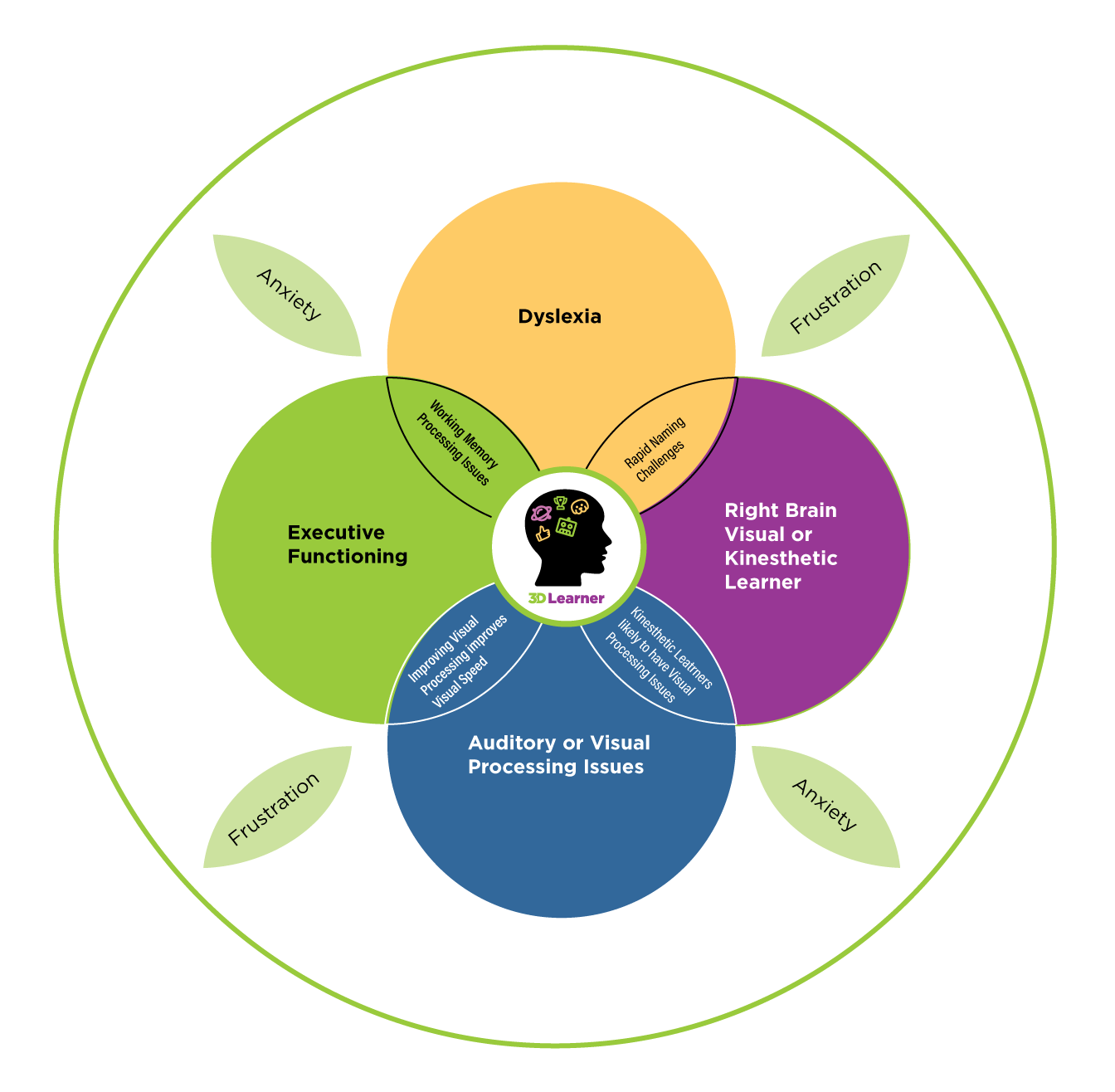
They students are often smart kids who are bright right brain kinesthetic learners with related challenges with significant upside potential.
They also often are not getting all the help they need to succeed for three reasons:
- Public and charter schools are often slow to identify dyslexia or a learning disability.
- Public and charter schools are moving to more and more phonics-based intervention. These teach necessary skills, but often are not sufficient to significantly increase reading comprehension and math levels.
- Most teaching in public and charter schools are not geared to:
- Teach the way a right brain kinesthetic learner learns best.
- Address executive function challenges.
- Address visual processing issues.
- Help a smart struggling child succeed.
A bright right brain kinesthetic learner often has the capability of making significant gains in months with the right outside help.
Consider three examples:
Melissa’s parents were told that third grade retention was a virtual certainty. She was told by a friend to contact us. While she did have a learning disability and dyslexia, she was also a bright right brain kinesthetic learner, who had an attention and working memory issue. Within a few months, she was able to score above grade level in reading comprehension and excel in middle school and beyond.
Alex was a 6th grader. He had never been identified with dyslexia or a learning disability. He had been diagnosed with ADHD. He was inattentive, hyperactive and impulsive. He had been a star baseball player, but now his batting average was down to 250 and he had only hit one home run the previous year. He had also been suspended twice within two months, for minor infractions.
Our assessment showed that Alex was a bright right brain kinesthetic learner; had well above average in intelligence amd had significant challenges with:
- Reading comprehension — both parents were surprised to learn he was 4 years below grade level
- Attention — he could focus for two minutes and then he was gone
- Evaluation skills.
Like many right brain kinesthetic learners he was
- Very creative, both in problem solving and in explaining why he did something wrong
- Prone to make bad decisions
With training, Alex was able to:
- Improve his reading comprehension 4 grade levels within 4 months
- Become an A/B student
- Avoid trouble for years to come
- Improve his baseball results from:
- A 250 batting average to over 400 and lead his team
- 1 to 10 home runs in a season, again leading the team
- See himself as a smart kid who learns differently
James’ parents were really frustrated. As an 8th grader, his reading comprehension was 4 years below grade level, and he avoided reading. By tapping into his strengths and interests and addressing his processing speed, he was able to improve his comprehension 4 grade levels within 4 months, increase his reading speed by 80 percent, excel in high school and earn scholarships to 3 schools.
These students succeeded because their parents chose a path that worked well for their child.
These students are often:
- Far brighter than present results would indicate.
- Bright right brain kinesthetic learners who have not been taught how to leverage their strengths
- Anxious and/or frustrated.
- Likely to not catch up and even more likely to fall further behind their peers — in the last six months.
2023 Challenges Are Larger Than We Have Recently Seen
Recently we have seen:
- 5th, 6th and 7th graders who are 2, 3, 4 and even 5 years below grade level in reading comprehension.
- 2nd, 3rd and 4th graders who are 1. 2 and even 3 years below grade level in reading comprehension
- Math problems, especially math word problems, an even more significant issue
- Anxiety and frustration levels that are far worse than during pre-pandemic years.
In an informal study of educators and psychologists, 3 themes emerged in this post pandemic era:
1–Readers who were above grade level are doing just as well if not better – they appear to have read even more during the pandemic.
2–Students who were on grade level pre-pandemic are at or near grade level.
3–Struggling students:
- Fell even further behind in reading comprehension.
- Are often even further behind in math – where prior year’s struggles make the next year much harder.
5 Steps to Help Your Bright Right Brain Kinesthetic Learner Succeed
STEP 1
Reject the status quo and focus on how your child can make significant gains within months.
STEP 2
Work with someone who can identify your child’s:
- Strengths
- Challenges
- Present Level of Performance
⇒⇒ Note, while many assessments focus on labels like dyslexia, learning disabilities, or ADHD, we have found it very helpful to assess for:
- Whether your child is a right brain and/or kinesthetic learner
- Various processing issues that include:
- Working memory
- Processing speed
- Attention
- Auditory processing
- Visual processing issues that are often missed
- Present levels of performance — especially for reading comprehension
STEP 3
Set BOLD Goals. These might include:
- Improving your child’s reading comprehension by 2 or more grade levels within 6 months
- Getting your child back to grade level in math
- Cutting homework time by 33%. For a child taking 3 hours to do homework each night, this could save each of you 5 hours a week and 100 hours over the next 20 week
- Improving their working memory and attention
- Boosting their self-esteem
STEP 4
Partner with an educator who can help:
- Your child achieve their goals
- You to be the coach and advocate your child needs
- Help you navigate the parent – – school connection to get the support your child needs
STEP 5
Be focused on the goals and open on the how
Public and Charter Schools often do not have programs that capitalize on a child’s strengths, identify and address their challenges, or help your child make significant gains within months.
If you have a bright right brain kinesthetic learner, or you just want a no cost conversation;
Call us at 561-361-7495 or
Click here to schedule a Stress to Success Conversation
Background on How We Learned About The Right Brain Kinesthetic Learner. We had tried various reading comprehension programs, dyslexia treatments and tutors. It was not until I learned about the right brain kinesthetic learner, that I developed the 3D Learner Program ® that helped my daughter to improve her reading comprehension 4.2 grade levels in 7 months and to become the teacher she never had.
3 things we know about these bright right brain kinesthetic learners:
- They can often struggle for years
- They can often become far more successful in all aspects of life
- They are 100 percent dependent on their parents finding the right help
Be the Parent Who Makes The Difference, Especially If Your Child is a Bright Right Brain Kinesthetic Learner with Significant Upside Potential
If you have a bright right brain kinesthetic learner, or you just want a no cost conversation;
Call us at 561-361-7495 or
Click here to schedule a Stress to Success Conversation

Parenting a bright right brain kinesthetic learner has been made more challenging as the request for private school slots exceeds availability. With a new Florida Law likely to provide private school vouchers for many more students, we expect private school demand to accelerate for the 2023-24 school year and beyond.
In this blog post, we will cover 3 scenarios where parenting a bright right brain kinesthetic learner has gotten harder, why it will get worse and what parents can do about it.
Given the very competitive nature of private schools, as a parent, you may find yourself wanting some help. We are only a phone call away. We have helped many parents navigate through some tough challenges, and best of all, we have helped many students do far better in private schools than others thought possible.
Consider how much different your child’s live would be when:
- Your child is doing far better in school.
- Your child’s self-esteem is much higher, and their anxiety is much lower.
- Their reading comprehension is 2 years better than it is now.
- Math is now a strength and math homework takes much less time and is done right.
- They are performing much better in a non-academic effort – karate, sports, music etc.
- Your anxiety and frustration is much lower.
For a no cost Private School Conversation, either:
– Call us at 561-361-7495
– Click here to schedule a Conversation
What is a Bright Right Brain Kinesthetic Learner
It’s important that we understand that we all have different strengths and areas that need strengthening. We DO learn differently, and although we need to learn using all modalities, when a child is struggling, it is important that learning is targeting a child’s strengths. A student who learns best when he or she sees and experiences information is how we characterize a BRIGHT Right BRAIN KINESTHETIC LEARNER. They often learn best when they can discover patterns and do far better with experiential learning that combines visual, kinesthetic and engaging strategies.
These students often struggle with:
- Reading comprehension and math, especially word problems
- Executive function issues (e.g., working memory, processing speed and attention)
- Auditory or Visual processing issues

These bright right brain kinesthetic learners face several challenges that make private schools challenging:
- They are often a lot smarter than their reading comprehension or math skills would indicate.
- Private schools often rely on entrance exams that are difficult for these students to pass-they are very “wordy”!
- Private school curriculums are often a year ahead of the public school’s curriculum. For a student who is a year or two below grade level, this puts them two or three years below what is expected.
- Many private schools are now offering expensive tutoring that schools may require, but they may not be what your child needs. Understanding HOW your child learns, is vital.
With Help, Many Bright Right Brain Kinesthetic Learners Can Succeed
Michael’s parents were furious. Despite a 132 IQ, the psychologist had recommended her son not go to a rigorous private school. He recommended another year of phonics-based training and that the parents enroll Michael in a school for students with learning disabilities and dyslexia. Looking at the two dyslexia treatments that were recommended, mom asked the psychologist, “Is there a third option that teaches the way my son learns?”.
He referred them to 3D Learner. Mom called us from the psychologist’s parking lot.
The first three questions piqued mom’s interests:
- Does your child remember places visited, even from years ago?
- Does your child learn best when he sees and experiences information?
- Is your child a lot smarter than present results would indicate?
It turns out Michael was a bright right brain kinesthetic learner with working memory and processing speed issues. We were able to significantly improve his reading comprehension, executive function skills and his confidence. Note, many right brain kinesthetic learners have excellent memories for what they see and experience, but not for what they read or hear. They are processing a great deal of information, but their visual processing issues often slows down their reading.
Michael did much better from day one, and he got into the rigorous private school and even better …
The young man graduated high school near the top of his class and later graduated from MIT.
⇒ All because mom decided to pursue a strength-based option for learning.
Her comment was, “You changed his attitude about himself and that was 90 percent of the battle”. KF Parkland, FL
For a no cost Private School Conversation, either:
– Call us at 561-361-7495
– Click here to schedule a Conversation
The Bright Right Brain Kinesthetic Learner Struggling to Keep Up
Sarah was struggling to keep up. The school recommended grade retention. When the parents rejected that, tutoring was recommended. Again, not consistent with what this bright right brain kinesthetic learner needed. Mom called a friend and described her challenge. The friend said, “I cannot help you, but I think Denise can”. Mom then called Denise and after an hour, they realized that both had smart kids who learned differently. Mom called and they came for the 3D Learner Program ®. Sarah was initially the lowest reader in her class and she avoided reading. By the next school year, she was at the top of her class in reading comprehension and the most avid reader. In a month-long competition, the average student read 180 pages, her best friend read 360 pages; Sarah read 720 pages. When asked why she now loved reading, Sarah said, “3D Learner taught me how to create videos and visuals for what I read, do you know how cool that is?”
The parents commented, “You showed us our daughter’s gifts, and helped transform her into an outrageously successful student” Mr and Mrs R, Florida
For a no cost Private School Conversation, either:
– Call us at 561-361-7495
– Click here to schedule a Conversation
⇒ All because a mom and dad chose to take the path less traveled.
The Student Who Is Doing OK, Can Often Excel, and Parents Are Not Aware Their Child is a Bright Right Brain Kinesthetic Learner
Parents are often baffled by the challenges their child faces. Many parents of bright right brain kinesthetic learners are not aware of their child’s strengths. Mary was visiting a friend, whose dyslexic son had been struggling in school. Mary and her friend were sitting in the kitchen when the young man walked into the living room with a book and devoured it. Mary asked, “What happened? Jake never read like that before.
Mom indicated they had come to us. Mary asked, “Does 3D Learner help kids who do not have dyslexia, are doing OK, but have the potential to do far better?” Her friend answered, “Yes, they do”. They help students who are creative and learn differently. Give them a call.”
Mary did and her daughter blossomed after our training. She went from a C- student to an A student and her confidence soared.
For a no cost Private School Conversation, either:
– Call us at 561-361-7495
– Click here to schedule a Conversation
Some Private Schools Are Not Right for Certain Right Brain Kinesthetic Learners
We have had cases where a school was not the right fit for a child. This is especially true when the school caters to the very bright and often gifted, high achieving students, and the student in question has a below average IQ.
Nancy had a case like this with her third child Max. Her other two children were well suited to this highly competitive school, but Max was not. In this case, we worked with the parents to find the right school. Since there was no room for the balance of the school year at the new school, we worked out a win-win situation where Max could stay at his present school, and we would supplement his education.
Bright Right Brain Kinesthetic Learners Can Often Excel, with the Right Help
If your child is facing challenges with a private school, consider four things:
- Is your child a lot smarter than present results would indicate?
- Might your child be a bright right brain kinesthetic learner, who would benefit from a different approach?
- Would you like to know how your child can make significant gains in months
- Would you like help from a Parenting Guide, who specializes in helping Parents to Navigate the Private School Puzzle.
Note, while the majority of our students are bright right brain kinesthetic learners, we also help students with executive function and related challenges
For a no cost Private School Conversation, either:
– Call us at 561-361-7495
– Click here to schedule a Conversation

We have had a number of calls from private school parents of bright right brain kinesthetic learners, (i.e., kids who learn best when they see and experience information). The private schools are flagging academic, or behavior challenges and the parents are not sure what to do. The surge in demand for private school slots is increasing the pressure on parents to either help their child improve or find another private school. It is important to note that Florida private school enrollment has continued to increase over the last nine years.
We expect this demand to continue as more families move from the Northeast, prefer private schools, an increase in state funded voucher programs, and with the increasing frustration with public schools.
The challenge for parents of smart struggling students is that private schools can now be more selective and may ask more parents of struggling students to find another school for their child. Even worse, with the pandemic, many smart struggling students are even further behind as a result of the pandemic.
Parental Challenge, Especially for Bright Right Brain Kinesthetic Learners
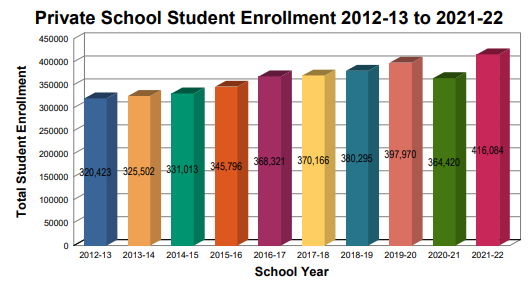
We have had a number of calls from parents this year asking about their options. Their child is struggling, the schools are making the parents aware of their child’s challenges, and now the ball is in the parent’s court. Some parents, who transferred from public or charter schools, are finding that the services and accommodations that were legally mandated at public and charer schools, need to be negotiated at private schools.
To make matters even more challenging, more private schools are shifting to phonics-based training. This may address one of the challenges their child has, but it does not address 4 big challenges. First, many of these students learn best when they see and experience information. They are what we call bright right brain kinesthetic learners. The phonics training certainly helps with reading fluency (i.e. how efficiently one reads), but it may not help as much with reading comprehension, math and writing deficits; second, many of these students have executive function issues (i.e. attention, working memory and processing speed) that virtually no schools address; third, visual processing issues (i.e. when a child skips words and lines when reading) are often not identified or addressed: and your child may now be more anxious and frustrated. In some cases, this may result in behavior challenges.
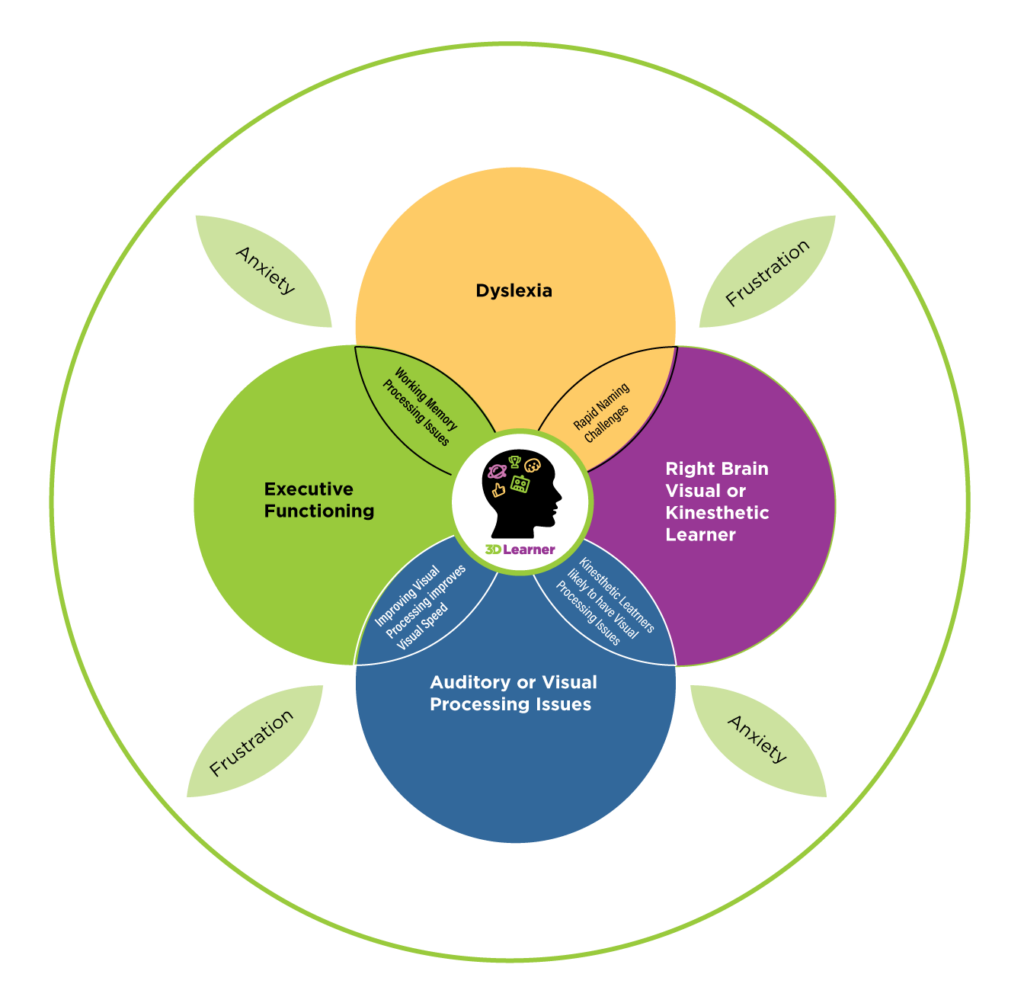
At 3D Learner, our goal is to address the whole child with an integrated, engaging and effect effort
Helping the Frustrated Parent with a Bright Right Brain Kinesthetic Learner
We have helped kids like these for over 25 years. Three advantages we offer parents are: We are collaborative advocates who can help you navigate a tense conversation; second, our assessment process is designed to identify a student’s learning style, strengths and challenges; and our learning process can be tailored to result in significant gains within months. This allows a student to succeed and opens up more options for the next school year.
Every situation is different. In a number of cases, we have helped the student make dramatic gains and allow the student to be far more successful than even their parents thought possible. In most cases, the student is able to stay at their present school. In rare cases, we help the parents to find a better placement for their child. Most changes are for the next school year, but occasionally immediately, when there is a need to change schools right away.
For parents of smart kids who learn differently and have multiple issues or difficulties, it is important to understand that: collaboration with private schools is important. They are not legally bound to provide extra services or accommodations. Second, for the child who learns differently, it is helpful to identify how your child learns best and what their challenges are. Third, outside help can be tailored to help your child succeed within months.
Since every situation is different, we offer a no cost 15-minute conversation to understand your options and to explore ways to work more effectively with your child’s school, to improve performance and to increase your options for next year.
If you would like to have a no cost conversation to discuss your bright right brain kinesthetic learner or any other issue, you can either:

(Located in Coral Springs — In Person and Zoom Training Available serving clients
from Parkland, Boca Raton, Coral Springs, South Florida and Nationwide)
Many students with dyslexia are a right brain kinesthetic learner. We start with 7 key premises:
- The right brain kinesthetic learner learns best when they see and experience information.
- A dyslexia treatment needs to address phonics and phonemic awareness
- The right brain kinesthetic learner often has a visual processing issue. They tend to have good peripheral vision, but their eyes often have difficulty converging. This results in their skipping words and lines when reading. We identify and address this issue, and work with optometrists.
- Working memory, processing speed and/or attention issues are quite common in this population. These are often the kids who can hyper focus on a video game and know the rules but have difficulty paying attention to that which is boring.
- Too often the right brain kinesthetic learner is defined by what he or she cannot do. These kids are often much smarter than present results would indicate
- Many of these kids fall further and further behind, but significant progress can be made in months
-
Informed, Empowered and Proactive Parents Make The Difference
If this sounds like your child, we offer a no cost Stress to Success conversation you can have by either:
– Calling us at 561-361-7495 or
– Clicking here to schedule a Stress to Success Conversation
A Mom on a Search for a Dyslexia Treatment That Works
A bright right brain kinesthetic learner had never come up in three years of her searching.
Mom was searching for a better dyslexia treatment. Her dyslexic daughter was really struggling with:
- Reading comprehension
- Dyslexia
- ADHD
- Homework time and stress — where it was often taking 2.5 hours to complete in 4th grade
- Self-esteem and anxiety
We asked mom what she had tried. The first dyslexia treatment was done by a traditional dyslexia tutor. The second was an investment of over $34,000. The challenge was her daughter’s reading comprehension was still at the 1st grade level as she entered 5th grade.
She knew her daughter had dyslexia and ADHD but was unsure what would help.
When she read an internet article on the right brain learner with dyslexia she was intrigued. Her daughter did learn best when she saw and experienced information.
It surprised her that most students with dyslexia are what we call right brain kinesthetic learners.
The terms right brain learner, kinesthetic learner and visual learner — are often used to describe the same child.
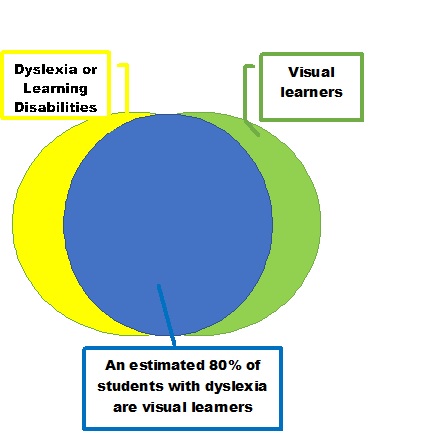
When she completed our visual learner screening tool, it was clear her daughter was a visual learner and would benefit from an approach that played to her strengths.
Mom was really surprised when she did our visual screening tool. Her daughter’s answers showed she appeared to have a significant visual processing issue.
But mom was confused. How could her daughter:
- Be a right brain kinesthetic learner without anyone ever identifying it
- Have what appeared to be a visual processing issues that no one ever identified
- Be struggling for years, without the right help — despite a massive investment of time and money
Mom then scheduled a no cost Stress to Success Conversation with 3D Learner, and learned that …
A Right Brain Kinesthetic Learner with Dyslexia, Executive Function and/or a Visual Processing Issue – is More Common Than You Might Think
Mom asked if Dyslexia, Executive Function challenges, and Visual Processing issues were often present in a right brain kinesthetic learner. One or both are often present.  The Right Brain Kinesthetic Learner often has executive function and
The Right Brain Kinesthetic Learner often has executive function and
visual processing issues, and may have dyslexia
Mom’s concerns included:
- Reading comprehension that was at the first-grade level — and her daughter was in 5th grade
- Her daughter was a slow reader and avoided reading
- Homework was taking 2.5 hours a night for both her daughter and mom
- Anxiety was rising for both of them
- There was no time to be a kid and enjoy life
The family was from Texas, and we are in Florida.
They came to Florida for a week and there were some clear issues and opportunities:
- We confirmed that her daughter’s reading comprehension was at the first-grade level
- Her reading speed was 115 words per minute, much slower than normal
- Attention was an issue
- The visual processing issue was real
- Mom dad and their child were eager to succeed
Over the next 6 months, their daughter improved as follows:
- Reading comprehension improved 4 grade levels
- Reading speed doubled
- Homework time decreased as follows:
- 50 percent for their daughter — saving over 6 hours a week
- 2 hours a night for mom — saving 10 hours a week
- Visual processing improved
- Their daughter learned how to learn as a right brain kinesthetic learner
If You Suspect Your Child is a Bright Right Brain Kinesthetic Learner
Download our “Is your child a visual learner” screening tool”
If your child has 10 or more of the characteristics, your child may well be a visual learner
Download our “Does my child have a visual processing issue” screening tool. Score one point for each infrequently, two points for sometimes, three points for fairly often and four points for always. A total of 16 points or higher indicates a visual processing challenge may exist.
Then, if you would like to discuss how to Transform Stress to Success, schedule a conversation by either

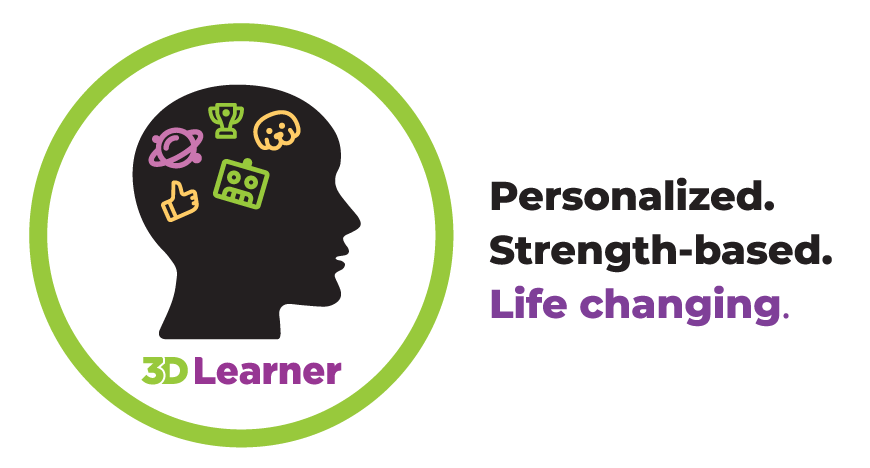
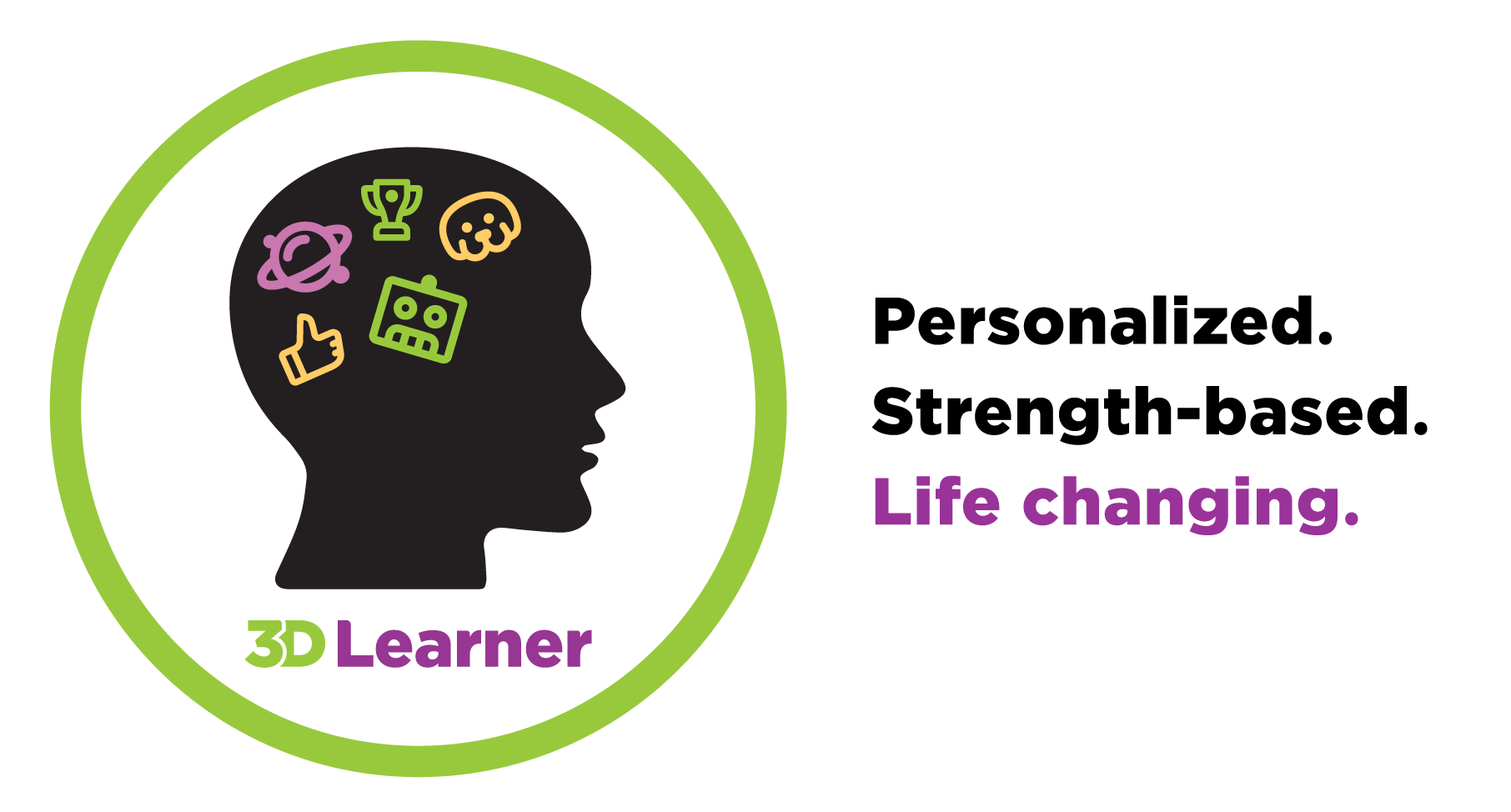








Recent Comments